IASbaba's Daily Current Affairs Analysis
Archives
(PRELIMS & MAINS Focus)
Syllabus
- Prelims – Geography
Context: Recently residents across western and northern New York are bracing for historic “lake-effect snow,” a storm set to engulf most of the region in a crippling white cloak.
How does lake-effect snow form?
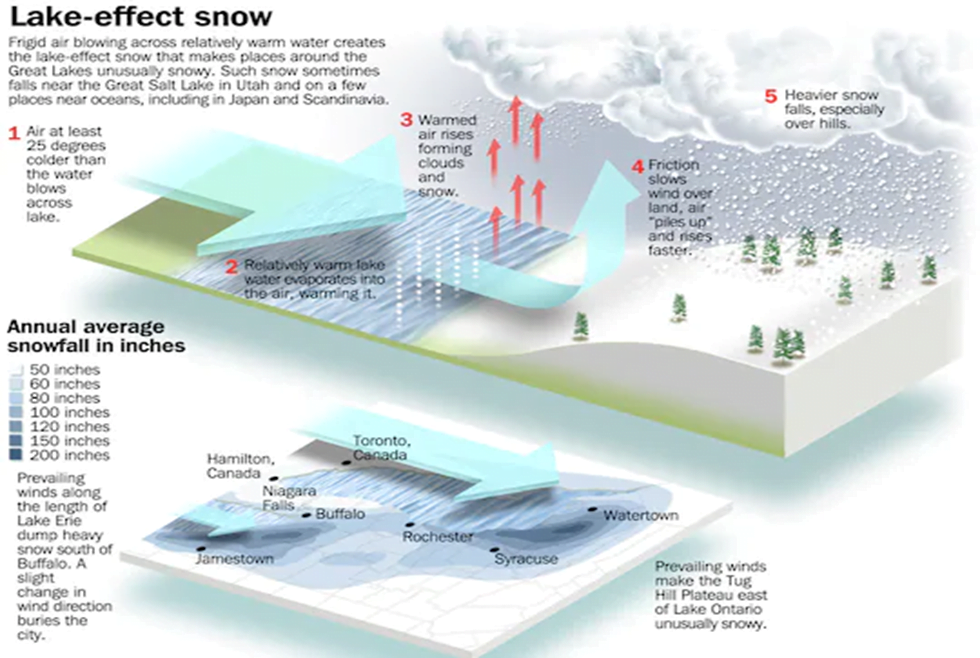
- Lake-effect snow forms when dry, freezing air picks up moisture and heat as it moves along warmer lake water.
- This causes some of the lake water to evaporate into the air, causing the air to be warmer and wetter.
- As the air cools and moves from the lake, it dumps all the moisture on the ground. When it’s cold enough, it results in a massive dumping of snow.
- The perfect recipe for lake-effect storms occurs during the late fall and early winter, when there is the largest difference between the warm lake water and the colder air moving over it.
- The bigger the temperature difference, the heavier the storm.
Will climate change affect lake-effect snow?
- Human-caused climate change has the potential to intensify lake-effect snow events, at least in the short term, according to the NOAA’s U.S. Climate Resilience Toolkit.
- “Ice cover extent and lake water temperatures are the main controls on lake-effect snow that falls downwind of the Great Lakes,”.
- The predictions change once lake temperatures rise to a point when much of what now falls as snow will instead fall as rain.”
- Lake-effect snow frequently pummels the Great Lakes with feet of wet snow that can trap people in their homes and covers cars.


Source: The Hindu
Previous Year Question
Q.1) Which one of the lakes of West Africa has become dry and turned into a desert? (2022)
- Lake Victoria
- Lake Faguibine
- Lake Oguta
- Lake Volta
Syllabus
- Prelims – Economy
Context: The Securities Appellate Tribunal (SAT) has upheld the order of insurance regulator IRDAI directing Go Digit General Insurance to discontinue the product “Digit Group Total Protect Policy” as the product falls under the purview of life insurance which could not be offered by a general insurance company.
About Securities Appellate Tribunal:
- SAT is a statutory body established under the provisions of Section 15K of the SEBI Act, 1992.
- The Securities Appellate Tribunal has only one bench which sits at Mumbai.
- It is under the jurisdiction of Ministry of Finance.
- Composition:
- SAT consists of a Presiding Officer and Two other members.
- The Presiding officer of SAT shall be appointed by the Central Government in consultation with the Chief Justice of India or his nominee.
- Powers and Functions:
- It has the same powers as vested in a civil court. Further, if any person feels aggrieved by SAT’s decision or order can appeal to the Supreme Court.
- To hear and dispose of appeals against orders passed by the SEBI or by an adjudicating officer under the SEBI Act,1992.
- To hear and dispose of appeals against orders passed by the Pension Fund Regulatory and Development Authority (PFRDA).
- To hear and dispose of appeals against orders passed by the Insurance Regulatory Development Authority of India (IRDAI).
About The Insurance Regulatory and Development Authority of India (IRDAI):
- History: Following the recommendations of the Malhotra Committee report, in 1999, the Insurance Regulatory and Development Authority (IRDA) was constituted as an autonomous body to regulate and develop the insurance industry.
- Made an independent statutory body in 2000 that was set up under the IRDA Act,1999.
- It is under the jurisdiction of Ministry of Finance.
- Mandate: It is tasked with regulating and licensing the insurance and re-insurance industries in India.
- Aim: To protect the interests of the insurance policyholders and to develop and regulates the insurance industry. It issues advisories regularly to insurance companies regarding the changes in rules and regulations.
- HQ: The agency’s headquarters are in Hyderabad, Telangana, where it moved from Delhi in 2001.
- Composition: IRDAI is a 10-member body including the chairman, five full-time and four part-time members appointed by the government of India.
Main Objectives:
- To ensure fair treatment and protect the interests of the policyholder.
- To regulate the insurance companies and ensuring the industry’s financial soundness.
- To formulate standards and regulations so that there is no ambiguity.
Functions:
- Granting, renewing, cancelling or modifying the registration of insurance companies.
- Levying charges and fees as per the IRDA act.
- Conducting investigation, inspection, audit, etc. of insurance companies and other organizations in the insurance industry.
- Specifying the code of conduct and providing qualifications and training to intermediaries, insurance agents etc.
- Regulating and controlling the insurance premium rates, terms and conditions and other benefits offered by insurers.
- Provides a grievance redressal forum and protecting interests of the policyholder.
Source: Indian Express
Syllabus
- Prelims – Economy
Context: Flagging the need to revive consumption demand in the economy, the Confederation of Indian Industry (CII) has urged the government to reduce personal income tax rates to increase households’ spending power in Union Budget 2023-23, slash the 28% GST rate on some consumer durables, and engender job creation in the hinterland.
About CCI:
- It is a non-government, not-for-profit, industry-led and industry-managed organization.
- It was founded in 1895,its headquarters is in New Delhi.
- It works to create and sustain an environment conducive to the development of India, partnering industry, Government and civil society, through advisory and consultative processes.
Initiatives by CCI: CII has embarked on smarter initiatives that enhance competitiveness of Indian industry by underlining the need for rapid up gradation on parameters like quality, corporate governance, knowledge management, energy efficiency and environment management.
- Specialised Services Division aims to provide solutions to organisations not just for their competitiveness needs, but also to help them become more self-reliant by helping them develop flexible strategies that cater to changing needs.
- Corporate Services Group assists companies maximise corporate and shareholder value through a range of activities covering : Consulting, Research Projects, Knowledge Based Events and Research Papers.
- Energy Management Division provides its expertise to domestic as well as overseas organisations. The range of services offered includes : comprehensive energy audits, in-house and centre-wise intensive training programmes, specific energy consumption norms, ‘Energy Conservation (Encon)‘ missions and international conferences / exhibitions on trends in energy efficiency.
- Environment Management Division facilitates the utilisation of national and international expertise through seminars, workshops and training programmes.
- It undertakes a wide range of programmes & awareness activities covering legal and technical aspects including design and implementation of Environment Management systems, Pollution Prevention and Waste Minimization Initiatives, Green Supply Chain Management, Environmental Performance Evaluation, Strategic Environmental Assessment, Sustainable Development and Environmental Planning, Hazardous Waste Management, Site Feasibility Assessment etc. are some of the other services offered.
- Green Services Division operates through the Green Business Centre (CII-GBC), offering niche Green Services to Indian industry.
- The objective of the CII-GBC is to promote Green Concepts leading to sustainable development, efficiency and equitable growth.
- Services offered : Green Process Certification, Green Building Certification (advisory services on construction of green buildings and award of Green Building certificate), Technology Centres, Training Programmes on Green related topics and business incubation facilitating entrepreneurs in developing and marketing new and innovative green products for commercialisation.
- Technology Services Division offers the following services to members : Technology Audit, Technology Export, technology transfer and problem solving skills from R&D and academic institutions (through CII TDB Technology Transfer Centres).
- CII’s Social Development and Community Affairs Council (SDCA) has pledged the allegiance of all members, taking the ‘More for India’ slogan to their boardroom agenda.
- SDCA’s various initiatives cover issues like education, child rehabilitation, women empowerment, rural development, human rights, population, healthcare and the control of HIV/AIDS.
- Through the Brand India Campaign, CII strives to Build Brand salience for India by positioning it as a “Globally Competitive and sound Investment destination and as a Reliable Partner to do business with.”
- The Integrity India Campaign takes on the challenge of “working to improve probity in public life by putting the issue of Integrity on the front burner”.
Source: The Hindu
Syllabus
- Prelims – Science and Technology
In news: An international team of scientists have completed the genome sequencing of the wild brown trout — one of the most genetically diverse group of vertebrates.
- It is part of an ambitious project to track the DNA of tens of thousands of lifeforms in the United Kingdom.
- It will answer a long-standing debate about whether they are a single species or several.
Brown trout:
- Also called, Salmo Trutta, it has only 3 to 50 species.
- It has 38 to 40 chromosomes and multiple copies of those chromosomes within its genome.
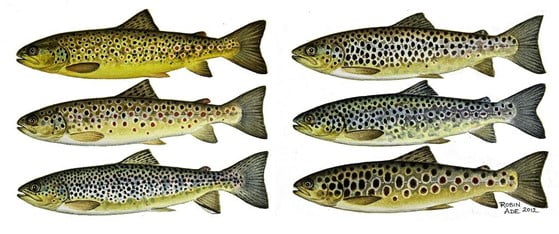
DNA Sequencing:
- DNA sequencing is the process of determining the nucleotide sequence of DNA (deoxyribonucleic acid).
- DNA is made up of four chemical building blocks – called “bases” – adenine, guanine, cytosine, and thymine.
- It involves determining the sequence of these bases which encodes the biological information that cells use to develop and operate.
- The nucleotide sequence is the most fundamental level of knowledge of a gene or genome. It is the blueprint that contains the instructions for building an organism.
- Human genome contains about 3 billion base pairs that spell out the instructions for making and maintaining a human being.
- DNA sequencing methods:
- Maxam-Gilbert sequencing
- Chain-termination methods
- Shotgun sequencing
- Single molecule real time (SMRT) sequencing
- Nanopore DNA sequencing
- In India, Next Generation Sequencing (NGS) facilities are available; which are also represented in the Indian SARS-CoV -2 Genomics Consortium (INSACOG).


Significance:
- Identify genetic traits that helped the species cope with environmental pressures, help trout adapt to relatively acidic waters and boost wildlife conservation during climate change.
- Learn about how trout adapt to different conditions, helping the management of wild and farmed fish stocks in future.
- Reveal the mythical ‘superpowers’ of the iconic brown trout that made them one of the first species to recolonise previously frozen freshwater areas from the sea at the end of the last Ice Age.
- Their unique genetic adaptations helped different populations to exploit biological niches, with some living their whole lives within a 200-metre stretch of freshwater stream while others migrate from the stream to the open sea.
Source: Down to Earth
Previous Year Question
Q1.) Consider the following statements : DNA Barcoding can be a tool to : (2022)
- assess the age of a plant or animal.
- distinguish among species that look alike.
- identify undesirable animal or plant materials in processed foods.
Which of the statements given above is/are correct?
- 1 only
- 3 only
- 1 and 2
- 2 and 3
Syllabus
- Prelims – Current Affairs
In News: India wins EXCELL Awards-2022 at International Conference on Family Planning held in Pattaya city, Thailand.
- India the only country to have received the award in ‘country’ category.
About the award:
- The International Conference on Family Planning (ICFP) has served as a strategic inflection point for the global reproductive health community, providing a global stage for more than 120 countries worldwide, organizations, and individuals to make important commitments and celebrate achievements as the world’s largest scientific conclave on family planning and reproductive health.
- It recognizes and applauds India’s achievements in ensuring increased access and adoption of modern contraceptive methods and significantly reducing unmet needs for family planning.
- It is a step towards ensuring access to quality family planning choices based on right information & reliable services.
India’s achievements:
- As per National Family Health Survey (NFHS) 5 data
- Overall Contraceptive Prevalence Rate (CPR) has increased substantially from 54 percent to 67 percent in the country,
- Unmet needs of family planning have witnessed a significant decline from 13 per cent to 9 per cent. The unmet need for spacing has also come down to less than 10 per cent.
- 68% modern method contraceptive users obtain their method from the public health sector.
- The total ‘demand satisfied’ for family planning among currently married women aged 15-49 in India increased from 66 percent in 2015-16 to 76 percent in 2019-21 which has already crossed the SDG target of 75 set globally for 2030.
- Mission Parivar Vikas is one of the government’s flagship programmes, to reduce unmet needs in family planning
Source: PIB
Syllabus
- Prelims – Current Affairs
In News: The Appointments Committee of the Cabinet has approved appointments to fill 23 vacancies, including 11 as judicial members and 12 as administrative members, in the Armed Forces Tribunal (AFT).
- The move will help fill up vacant positions many of whom have been unable to function because of shortfall of members resulting in huge backlog of cases.
About Armed Forces Tribunal (AFT):
- AFT is a military tribunal in India, established under the Armed Forces Tribunal Act, 2007.
- Powers: adjudication or trial by Armed Forces Tribunal of disputes and complaints with respect to commission, appointments, enrolments and conditions of service in respect of persons subject to the Army Act, 1950, The Navy Act, 1957 and the Air Force Act, 1950.
- Functions: Any appeal arising from court-martial orders, findings, or sentences is reviewed by the Armed Forces Tribunal Act
- The Principal Bench is located at New Delhi. There are ten other benches across the country.
- Judicial Members are retired High Court Judges and Administrative Members are retired Members of the Armed Forces who have held rank of Major General/ equivalent or above for a period of three years or more, Judge Advocate General (JAG), who have held the appointment for at least one year are also entitled to be appointed as the Administrative Member.
- The Tribunal shall transact their proceedings as per the Armed Forces Tribunal (Procedure) rules, 2008.
- All proceedings in the Tribunal will be in English. The Tribunal will normally follow the procedure as is practiced in the High Courts of India.
About the procedure:
- In a break from tradition, a retired officer from the Indian Defence Accounts Service (IDAS) has been appointed as an administrative member of the AFT.
- Prior to this, only retired Army, Navy and Air Force officers were appointed as administrative members of the AFT.
- The AFT benches can only be operational if judicial as well as administrative members are available to sit on them.
- While the judicial members are drawn from the retired judges of the high courts across the country, the administrative members are selected from retired defence services officers.
- In both categories applications are invited from interested individuals before being shortlisted and selected.
Source Indian Express
Syllabus
- Prelims – Environment
In News: A new ecological restoration technology developed by Indian scientists for ecological restoration is helping in revival of mangroves degraded due to rising sea levels, climate change and human intrusion in the Sundarbans in West Bengal.
- The project was initiated with help from the Department of Biotechnology in 2013 and is now likely to be extended to 100 acres; while the transplantation started in 2014.
Bio-restoration:
- It means reviving native ecosystem in degraded areas while maintaining diversity of original flora and fauna through regeneration but bringing down the regeneration period to four-five. Natural regeneration takes longer time to regenerate.
- Ecological restoration technology involves plantation of native salt-tolerant grasses and a diverse set of carefully identified mangrove species in different zones of degraded mangrove patches. It also involves the use of growth-promoting bacteria.
- The process begins with stabilising entire site of restoration by planting native salt tolerant grasses. An onsite mangrove nursery was developed to propagate mangroves for transplantation. Besides local mangroves and associate species, the nursery also grew threatened, endangered, and vulnerable species.
- In all, 22 species of mangroves and associate plants were grown to maintain native diversity.
- Mangrove forests having high diversity are more stable than those having less species diversity and diverse multispecies mangrove forests are more resilient to sea level rise.
- Small coastal patches of mangroves are highly vulnerable and fragmentation of the ecosystem is creating barriers to species movement and dispersal.
Mangroves in India:
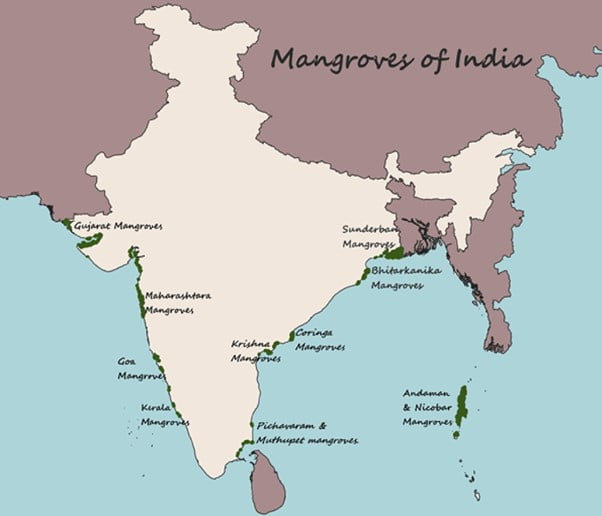
- As per the Indian State of Forest Report of 2019, mangrove cover in the country is 4,975 square km, which is 0.15% of the country’s total geographical area.
- The largest area under mangroves is in West Bengal (Sundarbans).
- Indian mangroves consist of 46 species representing about 57% of the world’s mangrove species.
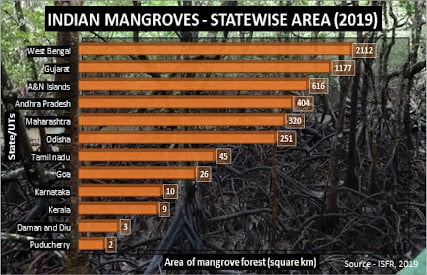
- In India, the mangroves are mostly located in the river estuaries and deltas; backwaters and islands.
- Broadly classified into three regions
- Deltaic or Eastern Coast Mangroves
- Estuarine & Backwater or Western Coast Mangroves
- Insular mangroves or Andaman & Nicobar Islands
- Deltaic or Eastern Coast Mangroves
- West Bengal – Sundarbans
- Odisha – Bhitarkanika (combined delta of the Mahanadi, Brahmini and Baitarani)
- Andhra Pradesh – Coringa (the Gautami-Godavari river)
- Tamil Nadu – Pichavaram and Muthupet mangrove (Cauvery)
- Puducherry mangroves.
- Estuarine & Backwater or Western Coast Mangroves:
- Gujarat(Gulf of Kachchh, Kathiawar; Gulf of Khambhat estuaries)
- Maharashtra (Mumbai, Thane creek)
- Goa coast – Zuari and Mandovi estuary
- Kerala Mangroves (Kannur, Kasaragod, Kozhikode, Ernakulam, Allepey)
- Daman and Diu mangroves
Miscellaneous:
- The Sundarbans is a protected wetland under the Ramsar Convention and is also a UNESCO World Heritage site.
Source: Down to Earth
Previous Year Question
Q.1) Consider the following pairs: (2014)
Wetlands : Confluence of rivers
- Harike Wetlands : Confluence of Beas and Satluj/Sutlej
- Keoladeo Ghana National Park : Confluence of Banas and Chambal
- Kolleru Lake : Confluence of Musi and Krishna
Which of the above pairs is/are correctly matched?
- 1 only
- 2 and 3 only
- 1 and 3 only
- 1, 2 and 3
Syllabus
- Mains – GS 3 (Environment)
Context: Recently, the Ministry of New and Renewable Energy organized a seminar on the National Bio Energy Programme in New Delhi in partnership with UNIDO and GEF as part of Azadi Ka Amrit Mahotsav along with launching of Biourja and Biogas portals.
- BioUrja portal has been developed as a single window platform to register and submit online applications for grant of Central Financial Assistance (CFA) to Waste to Energy projects, Biomass Briquette/Pellet manufacturing plants and Biomass (non-bagasse) based cogeneration projects.
- Biogas portal provides an overview on biogas related information.
About Biomass:
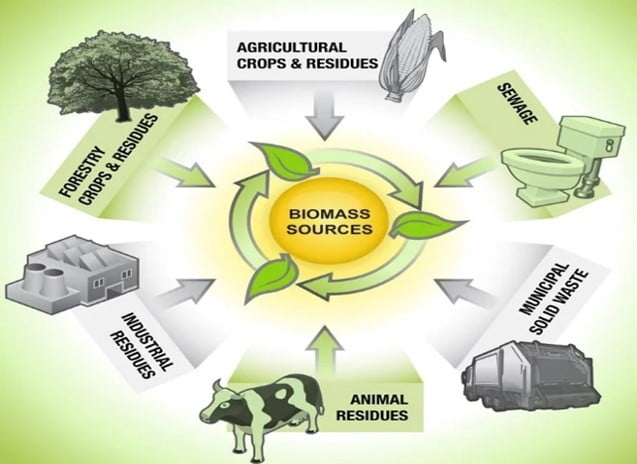
- Biomass has always been an important energy source for the country considering the benefits it offers.
- It is renewable, widely available, carbon-neutral and has the potential to provide significant employment in the rural areas.
- Biomass is also capable of providing firm energy.
- Biomass materials used for power generation include bagasse, rice husk, straw, cotton stalk, coconut shells, soya husk, de-oiled cakes, coffee waste, jute wastes, groundnut shells, saw dust etc.
Potential of Biomass:
- As per a recent study sponsored by MNRE, the current availability of biomass in India is estimated at about 750 million metric tonnes per year.
- The Study indicated estimated surplus biomass availability at about 230 million metric tonnes per annum covering agricultural residues corresponding to a potential of about 28 GW.
- This apart, about 14 GW additional power could be generated through bagasse based cogeneration in the country’s 550 Sugar mills, if these sugar mills were to adopt technically and economically optimal levels of cogeneration for extracting power from the bagasse produced by them.
About National Bioenergy Programme:
- The Ministry of New and Renewable Energy has notified the National Bioenergy Programme in November 2022.
- MNRE has continued the National Bioenergy Programme for the period from FY 2021-22 to 2025-26.
- The Programme has been recommended for implementation in two Phases:
- The Phase-I of the Programme has been approved with a budget outlay of Rs. 858 crores.
- It will comprise the following sub-schemes:
- Waste to Energy Programme:
- It is programme on Energy from Urban, Industrial and Agricultural Wastes /Residues to support the setting up of large Biogas, BioCNG and Power plants.
- Indian Renewable Energy Development Agency (IREDA) will be the implementing agency for the program.
- Biomass Programme:
- It is a Scheme to Support Manufacturing of Briquettes & Pellets and Promotion of Biomass (non-bagasse) based cogeneration in Industries to support setting up of pellets and briquettes for use in power generation and non-bagasse based power generation projects.
- Biogas Programme:
- To support setting up of family and medium size Biogas in rural areas.
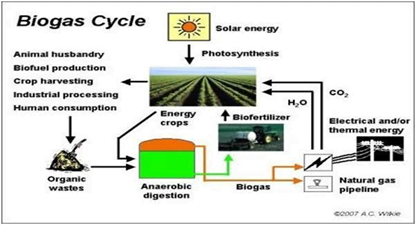
Significance of Bioenergy:
- Organic enriched Bio-manure: The digested slurry from biogas plants is a rich source of manure which shall benefit farmers in supplementing / reducing the use of chemical fertilizers.
- It is carbon neutral: As a natural part of photosynthesis, biomass fuels only release the same amount of carbon into the atmosphere as was absorbed by plants in the course of their life cycle.
- It reduces the overreliance of fossil fuels: Not only is there a limited supply of fossil fuels, but fossil fuels come with environmental baggage, including the release of large amounts of carbon dioxide into the atmosphere and the pollutants that result from removal, transportation and production.
- Less expensive than fossil fuels: While fossil fuel production requires a heavy outlay of capital, such as oil drills, gas pipelines and fuel collection, biomass technology is much cheaper. Manufacturers and producers are able to generate higher profits from a lower output.
- It helps in providing clean cooking through biogas.
- Co-firing in thermal power plants by utilizing biomass pellets and briquettes and BioCNG for transport.
- Setting up of biogas plants for clean cooking fuel, lighting, meeting thermal and small power needs of users which results in GHG reduction, improved sanitation, women empowerment and creation of rural employment.
Challenges before Bioenergy:
- Can lead to deforestation: Since wood is one of the most used sources of biomass energy, vast amounts of wood and other waste products have to be burned to produce the desired amount of power.
- While currently there is enough wood waste already, there is a risk of deforestation in the future.
- Biomass energy is not as efficient as fossil fuels: Some biofuels, like Ethanol, are relatively inefficient as compared to gasoline. In fact, it has to be fortified with fossil fuels to increase its efficiency.
- It is not entirely clear: While biomass is carbon neutral, the use of animal and human waste escalates the amount of methane gases, which are also damaging to the environment.
- Additionally, the pollution created from burning wood and other natural materials can be considered just as bad as that resulting from burning coal and other types of energy resources.
- Biomass construction plants don’t come cheap: The harvest, transportation and storage of organic matter can be costly and go beyond what other renewable sources need such as solar power.
Way Forward:
- India is capable of generating over 750 million metric tonnes of biomass each year, creating a huge potential for the generation of bioenergy.
- The Ministry of New and Renewable Energy has been promoting bioenergy in India since the 1980s to make use of the surplus biomass, cattle dung, industrial and urban biowaste that are generated within the country.
- The benefits of utilization of surplus biomass should reach the rural household by way of an additional source of income for farmers.
- The extra push in the form of a 20 per cent higher standard CFA (central financial assistance) pattern for the north-eastern region and Gaushala/shelter was the need of the time to create inclusiveness in an applied manner.
Thus, as a whole it will also support to national commitments in achieving climate change goals, along with reduction in import of natural gas and crude oil and buffer against crude oil/gas price fluctuations.
Source: PIB
Previous Year Questions
Q.1) “Biorock technology” is talked about in which one of the following situations?
- Restoration of damaged coral reefs
- Development of building materials using plant residues
- Identification of areas for exploration/extraction of shale gas
- Providing salt licks for wild animals in forests/protected areas
Q.2) According to India’s National Policy on Biofuels, which of the following can be used as
raw materials for the production of biofuels? (2020)
- Cassava
- Damaged wheat grains
- Groundnut seeds
- Horse gram
- Rotten potatoes
- Sugar beet
Select the correct answer using the code given below:
- 1, 2, 5 and 6 only
- 1, 3, 4 and 6 only
- 2, 3, 4 and 5 only
- 1, 2, 3, 4, 5 and 6
Syllabus
- Mains – GS 3 (Environment)
Context: Climate change has become one of the most significant threats to World Heritage properties, potentially impacting their Outstanding Universal Value, including their integrity and authenticity, and their potential for economic and social development at the local level.
Case Study: Survival of Mohenjo Daro
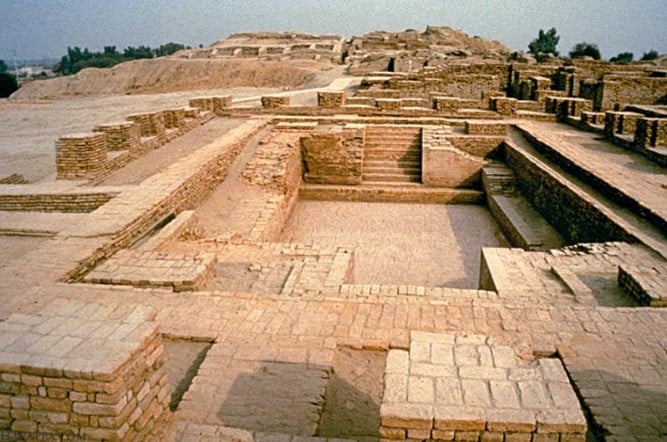
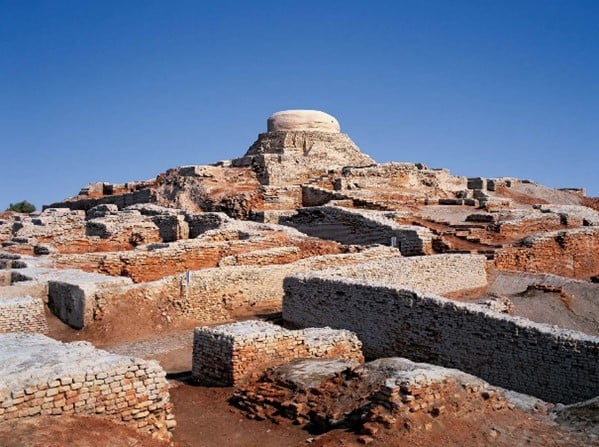
- One of the world’s first cities came close to being wiped off the map during tragic floods recently in Pakistan.
- Though Mohenjo Daro survived, it has become a symbol of the threat global warming poses to humanity’s cultural heritage.
- Built around 3000 BC by the Indus civilization in modern-day South Asia, Mohenjo Daro was not swept away by the floods, most likely thanks to the genius of its designers.
- Perched high above the Indus River, the city was equipped with a primitive drainage system and sewers, meaning much of the floodwaters could be evacuated.
- Nearly 1,600 Pakistanis died in the floods and 33 million others were affected in a disaster “probably” made worse by global warming, according to World Weather Attribution, a network of researchers.
- The Pakistani site was “a victim” of climate change and was “very lucky” to still be around, exactly 100 years since it was first discovered in 1922.
The impacts of climate change:
- Extreme weather and geological events:
- Of its 1,154 World Heritage sites, “one site in five, and more than a third of natural sites, already see climate change threat as a reality”.
- Floods:
- The world is experiencing many more incidents of floods, hurricanes, cyclones, and typhoons. Climate-related disasters are having a significant impact on sites such as Mohenjo-Daro.
- Temperature Rise:
- In Australia, the protected Great Barrier Reef is experiencing bleaching episodes due to rising water temperatures.
- High Erosion:
- In Ghana, erosion has washed away part of Fort Prinzenstein, which is conserved as a notable slave trading post.
- Forest fires:
- Huge forest fires have scorched the Rocky Mountains in Canada, which are a world heritage site, and this year flames came within 15 kilometres (nine miles) of Delphi as a heatwave intensifies the severity of wildfires across the Mediterranean basin.
- Landslides:
- In Peru, meanwhile, landslides occurred this year at the foot of Machu Picchu in the Andes mountains.
- Recently four people died and one was injured in a landslide that hit three houses in the Tharali area of Uttarakhand’s Chamoli district.
- Termites and drought:
- “Slow factors” that do not have an immediate impact pose “new kinds of risks in many of these sites”.
- These include invasions of wood-eating termites in areas that were previously either too dry or too cold for the insects to thrive.
- In other countries, the drying out of soil due to declining rainfall can have a “destabilizing” effect on some heritage sites.
- Under drought conditions, “the soils contract and make the foundations move”, then “swell suddenly when it rains”, which causes cracking. When parched and hard, they absorb less water, which promotes flooding.
- Water scarcity:
- In Mongolia, archaeological sites have been abandoned and then looted because “the population no longer had access to water”.
- Expected water shortages in the future could also lead to an increase in conflicts in which important heritage sites might be lost.
- Impact on Intangible cultural heritage:
- The uprooting of communities due to climate change threatens entire communities and ways of life.
- This includes the practice and transmission of a host of rich intangible cultural heritage practices – from oral traditions to performing arts, social practices, rituals, festive events, traditional craftsmanship, and interactions and relationships with nature.
- For instance, the changing availability of plant and animal species will lead to a loss of ecological knowledge and related language vital for the transmission of living heritage concerning food and medicinal plants.
Roadmap ahead to mitigate climate change: Global Initiatives
There is an urgent need to better understand, monitor, and address climate change threats to world heritage.
- Sendai Framework:
- There is a need to implement a new international approach to managing climate-driven disasters by shifting from a focus on reducing disaster losses to a comprehensive management vision – building on the Sendai Framework for Disaster Risk Reduction 2015–2030.
- Early warning:
- There is a requirement for an early warning system to alert protected area managers of emerging problems.
- Global assessment of climate risk:
- A global assessment of climate risk to all World Heritage sites is required so that the most vulnerable sites can be identified and resources for preparedness and resilience can be directed to the most at-risk sites.
- Sustainable Development Goals:
- Target 11.4 of the SDGs calls for “strengthening efforts to protect and safeguard the world’s cultural and natural heritage” and directly reflects the World Heritage Convention, which was the first international treaty to link these two elements.
- Paris Agreement:
- In the Paris Agreement, the new emphasis on preventing deforestation will increase the importance of forest conservation efforts in World Heritage sites, their buffer zones, and surrounding areas.
- Reductions in fossil fuel use:
- It will have the added benefit of reducing the number of World Heritage sites threatened by oil and gas exploration and development.
Further monitoring is required to better understand the effects of climate change on heritage sites and other natural hazards. The study has identified areas with urgent need for adaptation planning. The iconic nature of such sites can be used to promote awareness of the need to take action to mitigate climate change.
Source: The Hindu
Syllabus
- Mains – GS 2 International Relations
In News: India is assuming its G20 presidency for a year which is a significant development for India.
Context:
- G20 comprises 20 of the world’s largest economies, which represent around 85 per cent of the global GDP, over 75 per cent of international trade, and about two-thirds of the world population.
- India will join a small group of developing nations, which includes Mexico, China, Argentina, Saudi Arabia and Indonesia, that have assumed presidency of the group since the G20 started its annual apex-level summit after the 2008 global financial crisis.
- For the first time, the ‘Troika’ will comprise only developing nations.
What is G20 Troika:
- At the G20, the member holding the rotatory presidency every year, works together with its predecessor and successor and is together known as Troika.
- Aim: to ensure continuity of the agenda of G20.
- Currently Italy, Indonesia, and India are the Troika countries (all developing nations).
- India’s successor will be Brazil.
Significance for India:
- Unique opportunity to look at developments from the perspective of the developing world, turning the tables on the developed country members that have largely set the tone of discussions at the G20.
- Important issues such as food security, rising interest rates, indebtedness among some developing countries, the digital economy or climate change, is likely to be viewed keeping its effect on the poor and the vulnerable strongly in consideration.
- The G20 Presidency is a symbol of honour that comes with presiding over the world’s premier forum for global economic cooperation.
Challenges to G20 Troika:
- Russia-Ukraine war is continuing to wreak havoc on the global economy, disrupting supply chains and creating shortages of food and other essentials. On account of this, member countries continue to be split over the sanctions to be imposed against Russia.
- Unity: Internal governance reform is the need of the hour and India has to give thrust to inclusiveness and unity. This will help in thrashing out a consensus that will go a long way in setting a pragmatic, substantive agenda for the forum.
- Climate financing: developed countries have to be prodded for transfer of clean technologies and renewable energies to medium and low-income countries and India must showcase its exceptional solar energy record while doing so.
- The global economy is in the doldrums and there’s financial instability across the world. Hence, India has to chalk out a roadmap to deal with the situation by teaming up with the International Monetary Fund (IMF), Organisation for Economic Co-operation and Development (OECD), World Trade Organisation (WTO), and the Financial Stability Board.
- Other challenges include taking measures to ensure global food security. India must talk tough on a “code of conduct” for all G20 members and see to it that it is enforced.
Suggestions for future:
- Russia- Ukraine War: India’s decision to stay diplomatically close to the developed countries, such as the US, the UK, the EU, Japan and South Korea, who are calling for increased action against Russia, while continuing to maintain strong trade ties with Moscow, puts it in a unique position of communicating smoothly with both sides.
- The Leaders’ Declaration, based on consensus, was an achievement, as several features are of note, especially those on current political tensions, economic crises and climate change.
- On climate change: Commitments to achieve global net zero greenhouse gas emissions (carbon neutrality) around mid-century and keeping to the 1.5°C temperature limit must be attained.
- Developed countries must be reminded to fulfil their previous commitment to mobilise $100 billion per year “by 2020 and through to 2025”.
- The value of digital technology for multiple sectors — sustainable agriculture, trade, job creation, human capacity development, and inclusive industrialisation — must be reiterated, especially for developing countries.
- It is necessary to acknowledge the impact evident in the economic downturn, increasing global poverty and the delay in achieving the Sustainable Development Goals.
Way forward:
- India’s G20 priorities, as stated by the government, are inclusive, equitable, and sustainable growth, women’s empowerment, digital public infrastructure, and tech-enabled development, climate financing, global food security and energy security, among others.
- This is the moment when India can step forward and transition from being a rule-taker to being a rule-maker.
Source The Hindu Business line
Baba’s Explainer – Narco Test
Syllabus
- GS-3: Science and Technology
- GS-2: Governance & Human Rights
Context: A court in Saket, New Delhi, has allowed Delhi Police to conduct a narco test on Aaftab Poonawalla, the 28-year-old man accused of killing his 27-year-old live-in partner Shraddha Walkar in May 2022.
- Poonawalla allegedly chopped up Walkar’s body in many pieces, and disposed of them in a wooded area in South Delhi over several weeks.
- After police moved court seeking permission for the test, Poonawalla consented, telling the judge he was aware of the consequences.
Read Complete Details on Narco Test
Daily Practice MCQs
Q.1) Consider the following statements
- With reference to National Family Health Survey – 5, Unmet needs of family planning have declined from 13 per cent to 9 per cent.
- Mission Parivar Vikas aims to reduce unmet needs in family planning.
Select the correct answer using the code given below.
- 1 only
- 2 only
- Both 1 and 2
- Neither 1 nor 2
Q.2) . Which of the following statements is/are correct? Proper design and effective implementation of Bio restoration Programme can significantly contribute to
- protection of coral reefs
- resilience of mangrove forest ecosystems
- poverty reduction
Select the correct answer using the code given below.
- 1 and 2 only
- 3 only
- 2 and 3 only
- 1, 2 and 3
Q.3) Which of the following statements is/are correct regarding the Group of 20 (G20).
- The G20 countries are responsible for about 80% of World’s Carbon emissions.
- Germany, Singapore and Democratic Republic of Korea are the members of the group.
- India will join its ‘Troika’ in December 2022 along with Indonesia and Brazil.
Select the answer using the codes given below:
- 1 only
- 1 and 3 only
- 2 and 3 only
- 1, 2 and 3 only
Comment the answers to the above questions in the comment section below!!
ANSWERS FOR ’21st November 2022 – Daily Practice MCQs’ will be updated along with tomorrow’s Daily Current Affairs.st
ANSWERS FOR 19th November – Daily Practice MCQs
Q.1) – b
Q.2) – c
Q.3) – d













